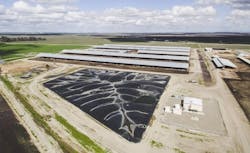Clean Energy and Maas Energy Works Building 9 RNG Production Facilities at Dairy Farms Using Lagoon Cover Digesters
According to the US Environmental Protection Agency, agriculture accounts for approximately 10% of all US greenhouse gas emissions, and the transportation sector accounts for another 28%. Capturing methane from farm waste and converting it into renewable natural gas (RNG) provides a solution for significantly lowering both sectors' greenhouse gas emissions on a lifecycle basis compared to diesel.
Based on this principle, Clean Energy Fuels, a provider of clean fuel for the transportation market, and Maas Energy Works, a dairy digester developer, have signed a new joint development agreement to build nine RNG production facilities at dairy farms across seven states.
The projects will collect manure from Colorado, South Dakota, Georgia, Florida, Iowa, Nebraska, and New Mexico - which have a combined herd size of approximately 35,000 cows - preventing methane emissions from entering the atmosphere.
“This joint venture is clear proof that family farms paired with private businesses are an unstopped force in achieving decarbonization. We will soon be capturing fugitive manure emissions and turning them into carbon-negative truck fuel with our partners at Clean Energy," said Daryl Maas, CEO of Maas Energy Works.
Maas Energy Works' process utilizes lagoon cover digesters, which involve a large tarp over a manure lagoon to capture the methane emissions. This process reduces the costs required to build and operate these facilities compared to tank digesters at comparable RNG plants. Clean Energy is financing the projects, and the nine sites are forecasted to cost approximately $130 million.
The nine projects, each subject to finalizing diligence before construction begins, are expected to be completed in 2026 and produce up to an estimated 4 million gallons of RNG annually. This negative carbon-intensity transportation fuel will then be distributed throughout Clean Energy's nationwide network of RNG stations.
About the Author
EnergyTech Staff
Rod Walton is head of content for EnergyTech.com. He has spent 17 years covering the energy industry as a newspaper and trade journalist.
Walton formerly was energy writer and business editor at the Tulsa World. Later, he spent six years covering the electricity power sector for Pennwell and Clarion Events. He joined Endeavor and EnergyTech in November 2021.
He can be reached at [email protected].
EnergyTech is focused on the mission critical and large-scale energy users and their sustainability and resiliency goals. These include the commercial and industrial sectors, as well as the military, universities, data centers and microgrids.
Many large-scale energy users such as Fortune 500 companies, and mission-critical users such as military bases, universities, healthcare facilities, public safety and data centers, shifting their energy priorities to reach net-zero carbon goals within the coming decades. These include plans for renewable energy power purchase agreements, but also on-site resiliency projects such as microgrids, combined heat and power, rooftop solar, energy storage, digitalization and building efficiency upgrades.
